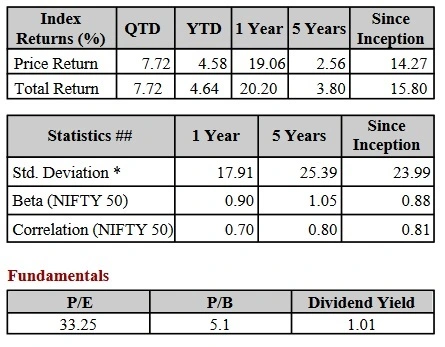The Nifty Auto Index stocks weightage is given in the first subsection below. This post is also helpful if you are interested in knowing more about the Index.
Table of Contents
What is Nifty Auto Index?:
The Nifty Auto Index is a widely recognized benchmark in the Indian stock market that tracks the performance of the automobile sector. The Index consists of 15 publicly traded automobile and automobile related companies in India. The Index is maintained by NSE and is calculated using free-float market capitalization.
The Index was launched on July 12, 2011 with a base date of January 1, 2004.
Companies Represented Under the Nifty Auto Index:
- 2,3 and 4 wheeler automobiles
- Heavy vehicles
- Auto Ancillaries
- Tires
Nifty Auto Index Stock Weightage:
The highest weightage is given to Mahindra & Mahindra Ltd. at 18.26% followed by Tata Motors Ltd. at 17.35%.
| No. | Stock Name | Trading Symbol | Weightage (%) |
|---|---|---|---|
| 1 | Mahindra & Mahindra Ltd. | M&M | 18.26% |
| 2 | Tata Motors Ltd. | TATAMOTORS | 17.35% |
| 3 | Maruti Suzuki India Ltd. | MARUTI | 16.51% |
| 4 | Bajaj Auto Ltd. | BAJAJ-AUTO | 10.28% |
| 5 | Hero MotoCorp Ltd. | HEROMOTOCO | 6.09% |
| 6 | Eicher Motors Ltd. | EICHERMOT | 5.46% |
| 7 | TVS Motor Company Ltd. | TVSMOTOR | 4.97% |
| 8 | Tata Motors Ltd DVR | TATAMTRDVR | 3.05% |
| 9 | Bharat Forge Ltd | BHARATFORG | 2.87% |
| 10 | Motherson Sumi Systems Ltd. | MOTHERSUMI | 2.76% |
| 11 | MRF Ltd | MRF | 2.69% |
| 12 | Bosch Ltd | BOSCHLTD | 2.55% |
| 13 | Ashok Leyland Ltd. | ASHOKLEY | 2.45% |
| 14 | Apollo Tyres Ltd | APOLLOTYRE | 1.53% |
| 15 | Exide Industries Ltd | EXIDEIND | 1.36% |
Nifty Auto Index Historical Performance:


The auto Index has given a return of 15.80 since its inception and a PE(Price to Earnings) ration of 33.25. Please refer to current market value of the index for a more accurate return %.
Factors Affecting Nifty Auto Index:
- Economic Condition: The performance of the Index is influenced by the overall economic conditions, including GDP growth, consumer sentiment, and interest rates. Under good economic conditions the consumer has more disposable income to spend on automobiles.
- Government Policies and Regulations: Government Policies such as taxation, emission norms, manufacturing guidelines, incentives, concessions and import export regulation can affect the price of automobile stock both positively and negatively.
- Global Automotive Trends
- Currency Fluctuations: Most of the companies in the Index have global operations and changes in exchange rates can affect their earnings which in turn affects the Nifty auto Index.
What is the Eligibility Criteria for Stocks to Be Added to the Index?:
A stock should satisfy all the below conditions before it can be added to the index
- Companies should form part of Nifty 500 at the time of review. In case, the number of eligible stocks representing a particular sector within Nifty 500 falls below 10, then deficit number of stocks shall be selected from the universe of stocks ranked within top 800 based on both average daily turnover and average daily full market capitalization based on previous six months period data used for index rebalancing of Nifty 500.
- Companies should form a part of the Automobiles sector.
- The company’s trading frequency should be at least 90% in the last six months.
- The company should have a listing history of 6 months. A company which comes out with an IPO will be eligible for inclusion in the index, if it fulfills the normal eligibility criteria for the index for a 3 month period instead of a 6 month period.
- Final selection of 15 companies shall be done based on the free-float market capitalization of the companies.
- Weightage of each stock in the index is calculated based on its free-float market capitalization such that no single stock shall be more than 33% and weightage of top 3 stocks cumulatively shall not be more than 62% at the time of rebalancing.
Index Re-balancing:
Index is re-balanced on semi-annual basis. The cut-off date is January 31 and July 31 of each year, i.e. For semi-annual review of indices, average data for six months ending the cut-off date is considered. Four weeks prior notice is given to market from the date of change.
Index Governance:
A professional team manages all NSE indices. There is a three-tier governance structure comprising the Board of Directors of NSE Indices Limited, the Index Advisory Committee (Equity) and the Index Maintenance Sub-Committee.
FAQ on Nifty Auto Index
How to Invest in Nifty Auto Index?:
To invest in the entire index you can buy the stock at the current weightage which can be quite costly or you buy an exchange traded fund which track the Nifty Auto Index like
- ICICI Prudential Nifty Auto Index Fund.
- Nippon India Nifty Auto ETF.
Can We Trade in Nifty Auto Index?
It is not possible to trade in Nifty Auto Index, but it is possible to trade the Individual stocks in the index.
Does Nifty Auto Index have derivative segment?
Nifty Auto Index unlike Nifty 50, Bank Nifty and Finnifty does not have a derivative segment. But most of the individual stocks in the Index do have a derivative segment.
How is Nifty Auto Index Calculated?
The index is calculated using using free float market capitalization method. Free float refers to the shares of a company that are available for trading in the open market. It excludes shares held by promoters, strategic investors, or locked-in shares. Weight of each company in the index is proportional to its market capitalization, adjusted for the number of shares that are freely available for trading in the market. This methodology ensures that the larger and more influential companies have a greater impact on the performance of the index.


